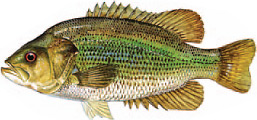 Scientific Name
Scientific Name
Ambloplites cavifrons
Other Common Names
Redeye, rock bass
Identification
Robust body much like the rock bass but with dark, olive green to olive brown back, fading to grayish sides and white belly. Has smaller scale spots than the rock bass and lighter small whitish or yellowish spots on its upper body. Has a slightly concave outline over the eyes. Checks scaleless or nearly so.
Best Fishing
Rivers: Meherrin, Nottoway, Blackwater, of the Chowan drainage; Roanoke/Staunton, Blackwater and Pigg of the Roanoke drainage. Lakes: Leesville Reservoir, Smith Mountain. Most of the trophy “rock bass” registered by anglers are really Roanoke bass.
Fishing Techniques
Spinning and spincasting with small to medium spinner baits, small spoons and crankbaits. Live baits include minnows, crayfish, and worms.
Feeding Habits
Eats especially crayfish and small fish, young eat crustaceans.
Habitat
Has one of the smallest ranges of native game fishes of North America. It occurs only in the Roanoke and Chowan River drainages of Virginia, and the Tar and Neuse River drainages in North Carolina. It is listed as a species of special concern because of impoundments, pollution and siltation on its native rivers. Inhabits large creeks, streams and small rivers. Prefers clear but sometimes turbid waters and the dark swamp waters such as the Nottoway and Blackwater. Look for them in fairly swift deep water runs but around rocks and gravel, or at the heads of pools.
Spawning Habits
Not a lot known about its spawning habits. Apparently nests in fairly fast currents. Constructs the circular nests in gravel or clay around mid-June. Male encourages passing females to his nest and guards eggs and larval young.

